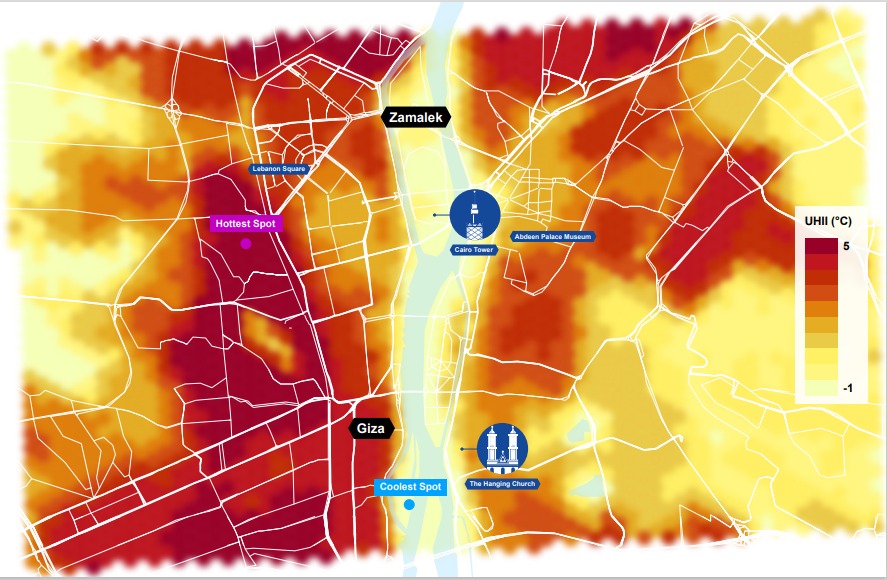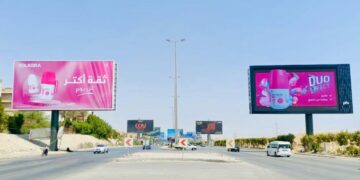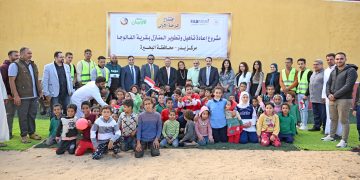
Cairo’s most extreme urban heat island «hot spot» revealed in new international study
Font size
Cairo’s most extreme urban heat island (UHI) “hot spot” saw temperatures spike 5°C hotter than rural surroundings, according to new research by global sustainable development consultancy, Arup.
Using Artificial Intelligence ‘AI’ and satellite images from space, Arup’s Urban Heat Snapshot mapped the most extreme UHI “hot spots” in a 150km2 sample of the urban centres of a diverse range of cities: Cairo, London, Los Angeles, Madrid, Mumbai and New York.
The study focused on the peak of a heatwave on the 11th of June 2022. In the majority of cities, the hottest spots had less than 6% vegetation cover while the coolest spots in most cities had over 70% and were found almost entirely in parks, away from residential areas.
This contributed to massive UHI swings within the cities, with “Bulaq Ad Daqrur” in Cairo, with no vegetation cover, experiencing temperatures around 6°C hotter than areas south of Qorsaya Island on the Nile, which benefits from nearly 60% of its surface being covered by natural features (28% vegetation and 30% water) and experienced temperatures 6 °C cooler.
The study also showed Madrid had the most severe UHI “hot spot” at 8.5°C, while New York city had the least severe at 4.5°C.
Dima Zogheib, Nature Positive Design Lead at Arup, said: ” We’ve inadvertently designed many of our cities to be hot. We’ve pushed out nature – concreted our streets, built high in steel and glass. And we’ve largely confined our green spaces to grand parks, away from where most people live”.
She Added: ” Ponds, lakes, trees, grasses, soils and other surfaces that allow water to permeate into the ground have to be seen as vital infrastructure, essential to helping us adapt to climate change. Our challenge as designers is to think creatively to strategically and equitably deploy nature throughout our cities. Today we have the advanced digital tools to help us rapidly pinpoint where investment in solutions can make the greatest impact.”
Cities are getting hotter due to climate change, with the number of cities exposed to extreme temperatures, 35°C and above, expected to triple by 2050. The World Bank estimates that climate change will increase temperatures in Egypt by between 1.5-3°C by mid-century. This will mean heatwaves become more frequent, severe and long, with an average of 40 additional days of extremely hot days per year projected.
Worryingly, four of the cities studied, including Cairo, experienced the worst UHI “hot spots” during the evening or night-time. Urban heat is a particular problem at night, due to materials like cement absorbing heat in the day then slowly releasing it when the sun goes down. This causes stress and health issues and acutely impacts vulnerable citizens – including children and the elderly.
UNICEF has noted Egypt is particularly vulnerable, with projected increase in heat waves, dust storms, storms along the Mediterranean coast and extreme weather events.
Arup’s Urban Heat Snapshot is designed to help cities understand how heat is impacting them from one neighbourhood to another and what can be done to reduce temperatures. It is one of the few international comparisons of the UHI effect on air temperatures during both day and night-time.
The authors of the report recommend cities focus on:
- Increasing tree canopy cover: Trees have proven to lower temperatures in cities and reduce heat-related mortality, as shown by a recent study in the Lancet of European cities increasing city tree coverage to 30%, could have prevented 2644 excess deaths.
- Creating more permeable surfaces: Permeable surfaces, such as bare or planted soil, tend to absorb less heat compared to impermeable surfaces like concrete or asphalt. Increasing permeable surfaces and allowing water to infiltrate into the ground will cool the surrounding environment.
- Using every space possible: More than half of the space in cities (including roofs and streets) is open space, providing a large canvas for building resilience. Measures can include greening building facades, greening roofs or using white paint to change the reflectiveness of surfaces to reduce the amount of heat absorbed from the sun.
- Establishing cool islands: With cities set for heatwave conditions every summer we need to create a network of cooling spaces in cities for people to take refuge. For example, something as simple as bringing back drinking water fountains to cities could improve health for citizens, becoming the main access point to water during a drought.
- Sparking behaviour change: People will also need to change the way they live in cities within the next decade. For example, incorporate siestas, re-consider office hours, introduce shop and restaurant closures over peak heat, and encourage the growth of an evening economy.
Arup, who recently participated in COP27 in Egypt speaking on climate action and resilience, is a key expert and advocate in the field of urban resilience, focusing on establishing the specific climate risks individual cities face; and create plans to reduce these risks or overcoming them.











